Barbara Shoup's Blog, page 2
July 13, 2015
One at a Time: Black Lives Matter
I did my student teaching in a second grade classroom at an inner city school in the fall of 1971. I was 24, idealistic, and utterly unprepared for the dawning realization that a lot of the teachers there had just given up on these kids, including my supervisory teacher—a nice, very beleaguered suburban lady, nearing retirement.I loved the kids, though I grew increasingly sad and even despairing as the time went on. I didn’t have the skills, the means, or the authority to do what I saw desperately needed to be done. But whenever I could I tried to find ways to help them, one at a time.One morning, Dante, a boy I especially liked (despite—or maybe because—the teacher had warned me that he was a troublemaker) was kept in from recess to finish a math assignment he’d rudely refused to do—and I was assigned to stay and make sure he behaved.It was a beautiful day. The sound of kids yelling and laughing wafted in through the open window. We could hear a basket being dribbled on the asphalt and the swish when it went through the net. I pulled a chair next to Dante, who sat sullenly, his head on his desk.Trying and failing to engage him, I finally asked, “Why won’t you do your work, Dante?” He looked up, tears rolling down his cheeks and said, “I can’t.”“Do you want to know something?” I asked. He nodded. “Math is really hard for me, too. In fact, I hate it. But it’s an important thing to learn. Will you try if I help you?”He said, Yes.”I still have the note he wrote me a few weeks after my student teaching term was over.“Dear Mrs. Shoup, I love you. Come to me. Dante. We r okay.”
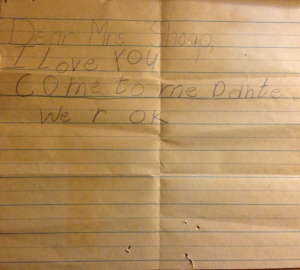 I still wonder what happened to him. I still hope that that little moment in time helped him see that he was way smarter than he’d been taught to believe he was. That he mattered.Nearly 45 years later, school remains an ineffectual, unhappy place for too many African-American kids. Often learning stops dead the first time they get behind on their reading or math, and there simply aren’t enough teachers and assistants to work with them, one-on-one, to catch up. And they’re lost.It breaks my heart.The kids I taught then are in their fifties now. They could be the grandparents of the kids I work with through “Building a Rainbow,” the Indiana Writers Center’s summer learning program at St. Florian’s Leadership Development Camp. I like to think they are.I like the sense of things coming full circle, too: St. Florian’s camp, where African American children are taught to live in the world by people who cherish them, is held at a school just a few blocks away from the grim, unwelcoming school where I did my student teaching.My favorite thing about “Building a Rainbow,” now in its sixth year, is sitting down with a kid–like Dante–who’s struggling, who doesn’t believe he can do what we’ve asked him to do. We talk, we brainstorm until a light goes on in his eyes, he picks up his pencil, and bends over the blank page. He’s found his voice. Suddenly, magically, writing seems possible. He shocks himself, writing a page, sometimes more as easily as talking.Sometimes I just stand and watch. Thinking, hoping that this moment will make him believe other things seem possible, too.The cool thing is that the room is full of instructors, college interns, and volunteers roaming around, looking for people who need help. The kids adore our interns and often sort of fall in love one or another of them, claiming them as their favorites.“Mr. Michael, help me.” Miss Kelsey, I need you.” “Miss Rita, I want you to read what I wrote.”Smiling, eager, their faces as open as books.May the fact that we’re there help them believe what we know:Black lives—their lives—Matter.
I still wonder what happened to him. I still hope that that little moment in time helped him see that he was way smarter than he’d been taught to believe he was. That he mattered.Nearly 45 years later, school remains an ineffectual, unhappy place for too many African-American kids. Often learning stops dead the first time they get behind on their reading or math, and there simply aren’t enough teachers and assistants to work with them, one-on-one, to catch up. And they’re lost.It breaks my heart.The kids I taught then are in their fifties now. They could be the grandparents of the kids I work with through “Building a Rainbow,” the Indiana Writers Center’s summer learning program at St. Florian’s Leadership Development Camp. I like to think they are.I like the sense of things coming full circle, too: St. Florian’s camp, where African American children are taught to live in the world by people who cherish them, is held at a school just a few blocks away from the grim, unwelcoming school where I did my student teaching.My favorite thing about “Building a Rainbow,” now in its sixth year, is sitting down with a kid–like Dante–who’s struggling, who doesn’t believe he can do what we’ve asked him to do. We talk, we brainstorm until a light goes on in his eyes, he picks up his pencil, and bends over the blank page. He’s found his voice. Suddenly, magically, writing seems possible. He shocks himself, writing a page, sometimes more as easily as talking.Sometimes I just stand and watch. Thinking, hoping that this moment will make him believe other things seem possible, too.The cool thing is that the room is full of instructors, college interns, and volunteers roaming around, looking for people who need help. The kids adore our interns and often sort of fall in love one or another of them, claiming them as their favorites.“Mr. Michael, help me.” Miss Kelsey, I need you.” “Miss Rita, I want you to read what I wrote.”Smiling, eager, their faces as open as books.May the fact that we’re there help them believe what we know:Black lives—their lives—Matter.
 I still wonder what happened to him. I still hope that that little moment in time helped him see that he was way smarter than he’d been taught to believe he was. That he mattered.Nearly 45 years later, school remains an ineffectual, unhappy place for too many African-American kids. Often learning stops dead the first time they get behind on their reading or math, and there simply aren’t enough teachers and assistants to work with them, one-on-one, to catch up. And they’re lost.It breaks my heart.The kids I taught then are in their fifties now. They could be the grandparents of the kids I work with through “Building a Rainbow,” the Indiana Writers Center’s summer learning program at St. Florian’s Leadership Development Camp. I like to think they are.I like the sense of things coming full circle, too: St. Florian’s camp, where African American children are taught to live in the world by people who cherish them, is held at a school just a few blocks away from the grim, unwelcoming school where I did my student teaching.My favorite thing about “Building a Rainbow,” now in its sixth year, is sitting down with a kid–like Dante–who’s struggling, who doesn’t believe he can do what we’ve asked him to do. We talk, we brainstorm until a light goes on in his eyes, he picks up his pencil, and bends over the blank page. He’s found his voice. Suddenly, magically, writing seems possible. He shocks himself, writing a page, sometimes more as easily as talking.Sometimes I just stand and watch. Thinking, hoping that this moment will make him believe other things seem possible, too.The cool thing is that the room is full of instructors, college interns, and volunteers roaming around, looking for people who need help. The kids adore our interns and often sort of fall in love one or another of them, claiming them as their favorites.“Mr. Michael, help me.” Miss Kelsey, I need you.” “Miss Rita, I want you to read what I wrote.”Smiling, eager, their faces as open as books.May the fact that we’re there help them believe what we know:Black lives—their lives—Matter.
I still wonder what happened to him. I still hope that that little moment in time helped him see that he was way smarter than he’d been taught to believe he was. That he mattered.Nearly 45 years later, school remains an ineffectual, unhappy place for too many African-American kids. Often learning stops dead the first time they get behind on their reading or math, and there simply aren’t enough teachers and assistants to work with them, one-on-one, to catch up. And they’re lost.It breaks my heart.The kids I taught then are in their fifties now. They could be the grandparents of the kids I work with through “Building a Rainbow,” the Indiana Writers Center’s summer learning program at St. Florian’s Leadership Development Camp. I like to think they are.I like the sense of things coming full circle, too: St. Florian’s camp, where African American children are taught to live in the world by people who cherish them, is held at a school just a few blocks away from the grim, unwelcoming school where I did my student teaching.My favorite thing about “Building a Rainbow,” now in its sixth year, is sitting down with a kid–like Dante–who’s struggling, who doesn’t believe he can do what we’ve asked him to do. We talk, we brainstorm until a light goes on in his eyes, he picks up his pencil, and bends over the blank page. He’s found his voice. Suddenly, magically, writing seems possible. He shocks himself, writing a page, sometimes more as easily as talking.Sometimes I just stand and watch. Thinking, hoping that this moment will make him believe other things seem possible, too.The cool thing is that the room is full of instructors, college interns, and volunteers roaming around, looking for people who need help. The kids adore our interns and often sort of fall in love one or another of them, claiming them as their favorites.“Mr. Michael, help me.” Miss Kelsey, I need you.” “Miss Rita, I want you to read what I wrote.”Smiling, eager, their faces as open as books.May the fact that we’re there help them believe what we know:Black lives—their lives—Matter.
Published on July 13, 2015 14:05
July 24, 2014
Creative Process Blog Tour
 Thanks, Sarah Layden, for inviting me to come along on this blog tour about creative process. For sure, read her forthcoming novel Trip Through Your Wires, which will be released by Engine Books in 2015. It’s good. Check out her post at sarahlayden.com
Thanks, Sarah Layden, for inviting me to come along on this blog tour about creative process. For sure, read her forthcoming novel Trip Through Your Wires, which will be released by Engine Books in 2015. It’s good. Check out her post at sarahlayden.comSo here goes.
What are you working on?
At the moment, I’m spending a lot of time to get the word out about my new YA novel, Looking for Jack Kerouac, which will be published by Lacewing Books on August 12. During the winter and spring, redrafted a short novel called The Green Heart of Lucy Cole, which I’ve been working on since 2007. It’s had various incarnations, but I think (hope) I’ve hit upon the right focus this time. When it’s polished up and ready to send out, I’ll go back to When It Happened Here, another novel I’ve struggled with over a number of years—and about which, I think (hope) I’ve hit upon the right focus. We’ll see.
How does your work differ from others of its genre?
I think my adult novels fall pretty squarely into mid-list fiction and my YA novels into realistic YA fiction. Honestly, though, I never think about this question. Each good book is its own universe and to try to figure out how it’s different from other fictional universes in any useful way seems fruitless to me. That said, I often study novels I love that are in some way or another similar to something I’m working on—hoping to trigger insights into the particular problems I’m trying to solve.
Why do you write what you do?
I’m fascinated by how chance, choice and opportunity affect (or don’t affect) how people live their lives. I like “turning point” novels, books that introduce some kind of change in a character’s life that plays out over the course of the story.
The things that shaped me as a young person were my dad’s drinking; an absurdly idyllic view of family life based on 50’s TV shows like "Father knows Best"; the longing to get away, to travel, to live in a larger world; the longing to have beautiful things in my life; and an awkward, unhappy adolescence. One or more of those things come into play in everything I write. Sometimes, as in An American Tune, I address them directly, as I did with the main character’s girlhood. Sometimes, as in Vermeer’s Daughter, set in 17thCentury Holland, I’m physically very far afield from my own life and the world I know. But my heart is still there.
For me, it’s all about being able to recognize not just a good idea, but my good idea—an idea that allows me to explore one or more of the set of issues it seems I’ve been set on earth to ponder.
For example, friend and fellow writer told me about his idea for a screenplay called "Beat," about a kid who goes to look for Jack Kerouac. I thought it sounded like a terrific idea for a young adult novel and said, joking, “If you ever decide you don’t want to do the screenplay, could I have the idea?” A few years later, he said, “Remember that Kerouac idea? I’m not going to do it, so you can have it if you want it.” “Cool,” I said. “Thanks!” But it was just an idea and I had a hard time finding a way to make it my own.
Then, sadly, one of my sisters died of brain cancer. Not long after her death, an image of her behind the counter of a diner floated into my mind’s eye. White blond hair in a pixie cut, freckles, turquoise eyes. There was Ginny! One of the most painful things about my sister’s illness and death was watching her two teenage sons go through it and, after I found Ginny (and the idea that I could, in a way, bring my sister back to life through her), it occurred to me that Paul might have had the same experience as my oldest nephew. At which point Looking for Jack Kerouac became about a whole lot more than a road trip for me. It was a way of processing my own grief about my sister and trying to better understand what losing their mother had been like for her boys.
For me, writing fiction is a way of looking sideways at something that I can’t see or can’t bear to see when I try to look at it directly. In the process of finding the story, coming up close to the emotions fueling it, I come to better understand my own life.
How does your writing process work?
It takes me a long time to write a novel. Years. Usually an image or phrase will pop up and I’ll write what almost always turns out to be a first chapter, but sometimes it takes a while to figure out exactly what the chapter is about and how to proceed. Getting the first draft of the novel down is the hardest part for me.
I almost always work chronologically through a novel from beginning to end, revising when I feel like I can’t keep going unless I assess and adjust what I have. Revision is less cutting, more expanding. Fleshing out scenes, adding new scenes, building better transitions. Then lots and lots of tinkering, polishing, which is my favorite part.
I rarely show my work to anyone before I’ve done everything I can figure out to do to make the novel on the page match the one in my head. When I get to that point, I will ask for reader feedback. I’m lucky to have several people (some writers, some readers) whose critiques are always spot on. Their questions and observations about the manuscript help me see the gaps between what I want the novel to be and what I’ve actually managed to get on the page. (Good book clubs are fabulous for feedback, too!) I do a lot of drafts, so I don’t use all of my readers at once. That way, there's always someone out there to give a fresh look. I often put a novel away for months or, in some cases, years—especially when there are structural and/or point of view issues that I just can’t get my head around.
It’s a crazy thing to do, writing novels.
I love what Jack Kerouac said about it. “And this is the way a novel gets written, in ignorance, fear, sorrow, madness, and a kind of psychotic happiness that serves as an incubation for the wonders being born.”
Published on July 24, 2014 04:24
June 30, 2014
Camran's Sister
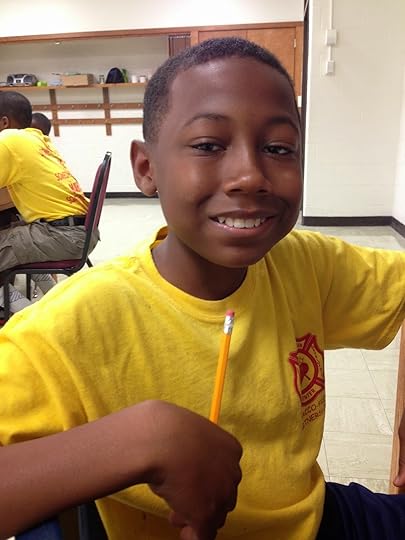
The Indiana Writers Center’s annual summer program, "Building a Rainbow," is in full swing. I love driving down to St. Florian’s Youth Development Camp on Monday and Wednesday mornings, knowing I’m about to spend a couple of hours with a bunch of extraordinary kids—not to mention the firefighters who founded the summer camp and spend a whole lot of their off-time planning, fundraising and then actually being with the kids all day every day for six weeks.
I especially love sitting down with a kid who seems to be struggling for words and talking with him, asking him questions until something magic happens and, suddenly ,there's a torrent of them and he can’t write fast enough to get them down. This happened one day last week with a kind, thoughtful boy named Camran. He’s new to the camp this year (some attend from the time they’re six until they graduate from high school) and was feeling a bit overwhelmed by it all. He couldn’t think of anything interesting to write, he told me, because he didn’t have an interesting life. After a few questions, he revealed that he’d lived with his sister in fifteen different houses since he was a baby.
“That sounds pretty darn interesting to me,” I said. “And your sister sounds amazing. Tell me about her.”
His face lit up in a huge smile and there came that torrent of words. Here they are.
My sister, Crystal, was always there for me. She chose to take care of me. She didn’t have to take care of me. She dropped out of college to take care of me. She made sure we had somewhere to stay every night. She made sure I ate before she ate. We lived in a couple different houses. We stayed with Andrea, who had a daughter. We played with her all the time. She made the kids happy. We stayed with a girl named Neisha. She had a big TV. She bought me a turtle. I named him Johnny Rico. Mama Buder let us stay with her a little bit. Then we moved to Mama JB’s when I was in kindergarten and we stayed there till I was seven. Mama JB had a daughter who had kids and the kids would always play with us. We played with their dogs, Bruce and Princess, too. Then my sister got a job at the police department. We got our own apartment. She also works part time at Warren High School and at the fireworks store in the summer. She is taking classes at college now.
My sister has black hair down to her shoulders. Her favorite shoes are Jordans. She likes to go hat shopping for baseball hats and other hats that look really cool. She likes jerseys, too. But she doesn’t get them for her, she gets them for me. My sister has a kind heart.
Well. That made my day.
And all over the room the same kind of thing was happening. The success of our program is directly related to the number of instructors, interns and volunteers available to sit down one-on-one with kids and coax out their stories. Our interns are college students, many of whom are education majors who will soon have their own classrooms. One of our requirements for them is that they write the prompts we ask the kids to write and share them with the group.
Writing teachers should write what they ask their students to write, we believe. For the joy of it, but also to remember how intimidating the blank page can be.
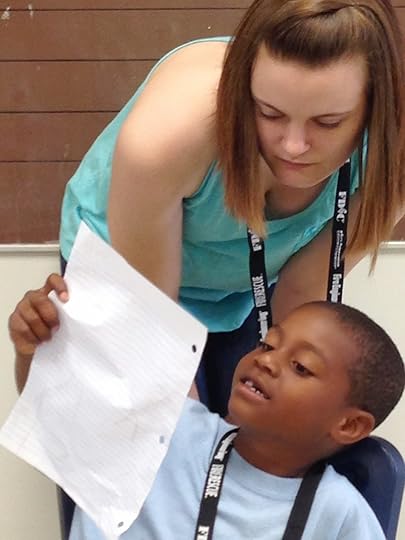
The interns learn as much as the kids do—about teaching and life. As one intern so eloquently put it at the end of last year’s program:
"These children with their bold, simple statements, wild imaginations, and truthful declarations are truly inspiring creatures. Through their honest eyes and even more honest words I became inspired to be a better writer, a better educator, a better person. I allowed their fun personalities to affect my life for the better. I laughed along with them at their comic stories; my heart wept for them with each tear they cried while writing a meaningful piece; I read their words, full of desire to know more, to know every detail possible. I learned being sad and admitting to it is okay and I learned being happy five minutes later is a matter of pure strength. I now understand writing is better when laughing and joking and that no matter how loud or quiet the room, a child’s written voice will always be voluminous.”
We are all writers, we tell the kids. We’re a community of writers. Writers need each other.
Which is true. I know I need them. Nothing makes me feel more right in the world than working with young writers who are just learning that they have stories to tell and discovering the power of words in the telling.
And by the way, our program still isn’t fully funded. If you’d like to help us meet the cost of this important work with young people, click here. We’d really appreciate it.
Published on June 30, 2014 04:20
March 11, 2014
Even the Wallpaper at Ragdale Makes Me Happy
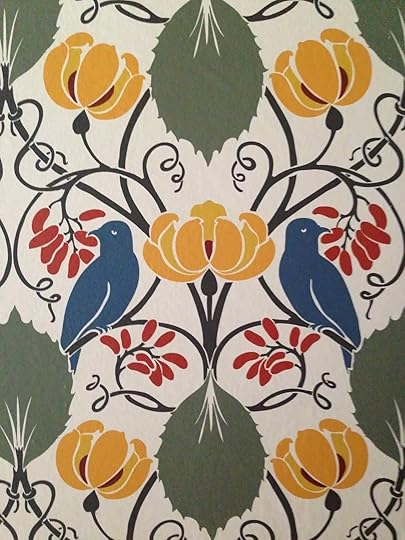 I have this thing about houses. House angst, really, resulting from the misguided idea that in the perfect house life would always be happy. And the house I have always had in mind is an awfully lot like Ragdale: beautiful inside and out, cozy and spacious at the same time, full of color and light.
I have this thing about houses. House angst, really, resulting from the misguided idea that in the perfect house life would always be happy. And the house I have always had in mind is an awfully lot like Ragdale: beautiful inside and out, cozy and spacious at the same time, full of color and light. The thing is, I am always happy at Ragdale: the house itself (my temporary home in Room at the Top of the Stairs, the leggy geraniums blooming on the sun porch, the sunny blue and yellow kitchen), the magical, energetic silence of people at work all around me. Even the wallpaper makes me happy.
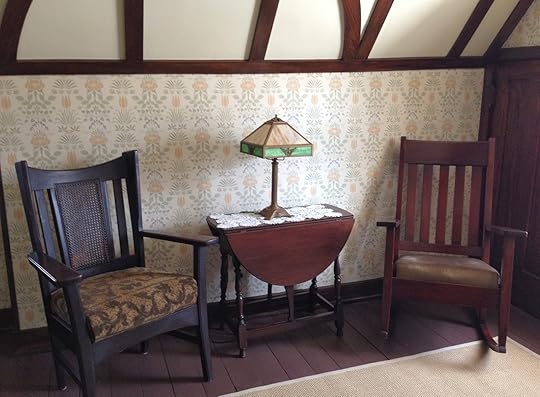 I’m half-convinced I would always be happy here, if I could just…stay.
I’m half-convinced I would always be happy here, if I could just…stay. But of course I know I can’t. And I love my real house, my real life. Into my second week here, I’m already feeling the tug of it calling me back.
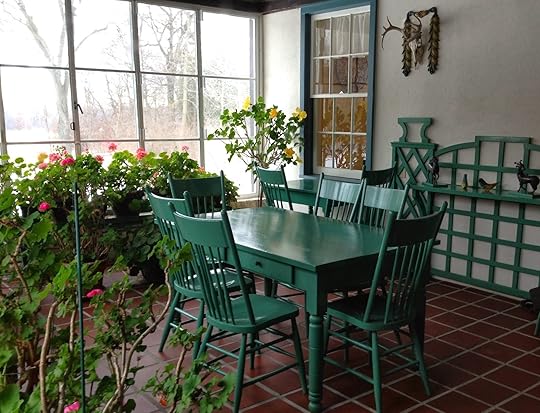 Meanwhile, I am so grateful for this gift of time in which there’s nothing to do but writing, thinking about writing, talking about writing (and everything else under the sun) with people believe in the arts and are intensely engaged in making their own worlds with words or paint or musical notes or photographs in this beautiful place.
Meanwhile, I am so grateful for this gift of time in which there’s nothing to do but writing, thinking about writing, talking about writing (and everything else under the sun) with people believe in the arts and are intensely engaged in making their own worlds with words or paint or musical notes or photographs in this beautiful place.
Published on March 11, 2014 08:54
February 19, 2014
Talking about Writing X 2
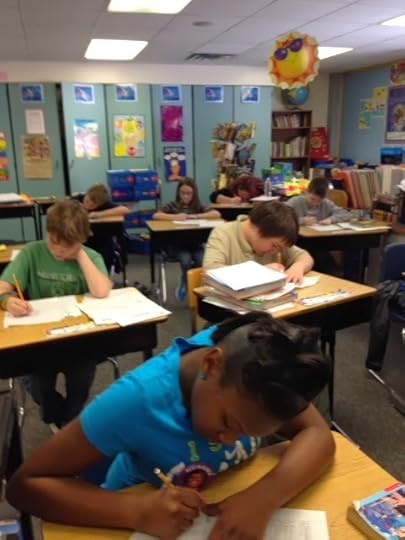 I gave two writing talks yesterday. One to Mrs. Brown’s fifth graders at Allisonville school; the other to a group of library patrons in Thorntown, mostly senior citizens. I’ve visited to Mrs. Brown’s class every year for a while now. She does a book project with her students--turning them all into authors, and I go to give them writing tips. The books the students write are charming, with the typed copy pasted in, illustrations and—best—the author’s bio at the back. They are a whole lot of extra work for Mrs. Brown, which she does gladly. Her classroom is bursting with things to look at and think about. When she brings me up to date on what the kids are working on, I can tell she’s as curious and engaged as she wants them to be.
I gave two writing talks yesterday. One to Mrs. Brown’s fifth graders at Allisonville school; the other to a group of library patrons in Thorntown, mostly senior citizens. I’ve visited to Mrs. Brown’s class every year for a while now. She does a book project with her students--turning them all into authors, and I go to give them writing tips. The books the students write are charming, with the typed copy pasted in, illustrations and—best—the author’s bio at the back. They are a whole lot of extra work for Mrs. Brown, which she does gladly. Her classroom is bursting with things to look at and think about. When she brings me up to date on what the kids are working on, I can tell she’s as curious and engaged as she wants them to be.She is one of my heroes. She’s one of those teachers who should be cloned or, at the very least, given a place at the head of the table where the discussions about what schools should be are taking place. Or better yet, figure out how to clone her. Schools full of Mrs. Browns would get better all on their own.But that’s a whole other topic. I want to write about my day of two writing talks. I began by asking Mrs. Brown’s students, “What is the hardest thing about writing for you?” Hands shot up. Everythingabout writing is hard for me. I can’t think of anything interesting to write about. I have an idea for a story, but I when I try to write it down I can’t. Sometimes I get a story finished, but then when I type it up I think there isn’t enough, but I don’t know how to add more. Sometimes I get part of a story done, but I don’t know what happens next—so I stop. Sometimes I get off-topic. I keep stopping to fix the parts I think are wrong, but then I can’t get going again. First, I say, “Writing is hard for writers, too. Writing is supposed to be hard. If it’s hard for you, you have something in common with all the great writers who ever lived.
Then I tell them some things I’ve figured out about writing. Everybody has interesting stuff to write about, we have to learn how to trick our brains into finding it for us. Ideas aren’t words, so we have to learn how words work so that we can translate our ideas into stories. Writing gets easier (and way more fun) when you learn how your brain works and let it help you: part of it is made for picturing the story in your mind so that you can just write down what you see; part of it is made for fixing up the story and making it better once you get it written down. Let yourself stay in the part where the pictures are in the first part of writing. Nobody gets a story perfect the first time they write it. Writers re-think and revise. You can go back and look at what you’re written, look for words that you can make more like pictures. Avoid adjectives, use strong, visual nouns instead. Take out adverbs! For example, “walking slowly” might become strolling, sauntering, meandering, limping—depending on how the person is walking and what you want the reader to know. When you get stuck and can’t go on, ask yourself, “What if?” A good imagination is no more than the writer being willing to ask “What if?” until the right thing pops into her mind. Don’t worry about fixing things as you go along. Just write as fast as you can, write everything you can think of--then you can think about fixing them. It’s okay to go off-topic in the first part of writing. Sometimes what feels like being off-topic is just your brain having a better idea about what the story should be. Let it go, see what you’ve got. If the off-topic part doesn’t work in the end, take it out. If you worry too much about getting it right the first time, the pictures stop coming and you get stuck. Remember: writers revise. You can fix what needs to be fixed when you finish getting your story down on the page.Mrs. Brown requires serious note-taking, so most of them were scribbling madly. I love that. We did an exercise that helped them see something they remembered. Then they wrote, not worrying about anything but getting down the pictures they saw in their heads. Watching people of any age do this exercise makes me supremely happy. A particular kind of quiet falls, there’s the sound of pencils scratching. The kids are bent over their papers, each in his own little world.
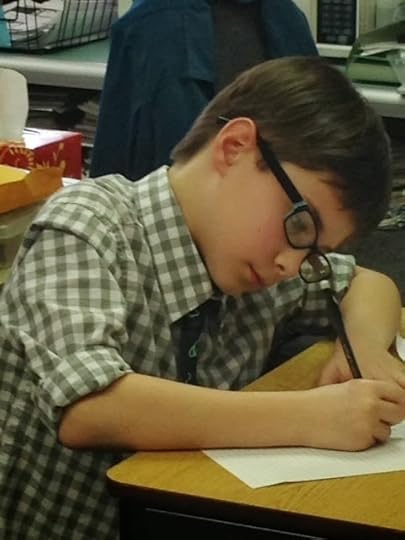 When the timer went off, they looked a little stunned to be back in the classroom. “What did that writing that way feel like?” I asked. Different. Easy. My hand hurt. I couldn’t write fast enough. I didn’t get stuck. It felt…light. I wrote so much. One boy never looked up at all. He just kept writing. And writing. He was still writing when the bell rang and it was time for me to leave.
When the timer went off, they looked a little stunned to be back in the classroom. “What did that writing that way feel like?” I asked. Different. Easy. My hand hurt. I couldn’t write fast enough. I didn’t get stuck. It felt…light. I wrote so much. One boy never looked up at all. He just kept writing. And writing. He was still writing when the bell rang and it was time for me to leave.
 A few hours later, I was on the interstate heading for the Thorntown Public Library, about twenty miles away from Indianapolis, where tseven library patrons showed up to talk about writing. We met in the young adult section of the old Carnegie Library, a cozy space. The whole library feels cozy. In fact, it’s so cozy, it has a lovely ginger cat in residence. Tober checked in on us now and then. He has his own blog, which you can read at http://tobersadventures.blogspot.com/.
A few hours later, I was on the interstate heading for the Thorntown Public Library, about twenty miles away from Indianapolis, where tseven library patrons showed up to talk about writing. We met in the young adult section of the old Carnegie Library, a cozy space. The whole library feels cozy. In fact, it’s so cozy, it has a lovely ginger cat in residence. Tober checked in on us now and then. He has his own blog, which you can read at http://tobersadventures.blogspot.com/.Speaking of people who should be cloned. I vote for Karen Niemeyer, librarian, and Christine Sterle. They’ve made the Thorntown Public Library a place where patrons feel at home. Everyone in the group knew each other; Karen and Christine knew them all by name. And Karen didn’t just get the program going and get back to work. She stayed and talked and wrote. Christine was working at the desk just outside the door to the YA room, but when the flow of check-outs slowed down, she wheeled her office chair into the room to join us. That made me smile.
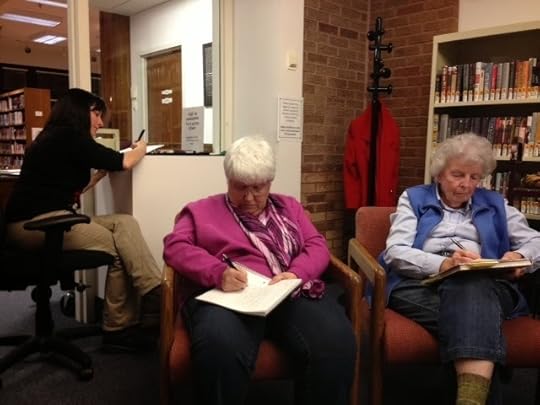 Two very different places; two very different audiences. But the Thorntown group’s questions and concerns about writing were exactly the same as the fifth-graders’ had been. I talked about exactly the same things I’d talked about earlier in Mrs. Brown’s classroom. We did the same writing exercise. The older audience had exactly the same reaction.
Two very different places; two very different audiences. But the Thorntown group’s questions and concerns about writing were exactly the same as the fifth-graders’ had been. I talked about exactly the same things I’d talked about earlier in Mrs. Brown’s classroom. We did the same writing exercise. The older audience had exactly the same reaction. I think (hope) each group of people left feeling that writing was more possible for them, feeling inspired to start (or finish) that story they’d been thinking about…now.
I know how I felt: full of energy, feeling really, really lucky to get to talk about writing two times in one day!
Published on February 19, 2014 05:41
February 9, 2014
Our Vicarious Boyfriends
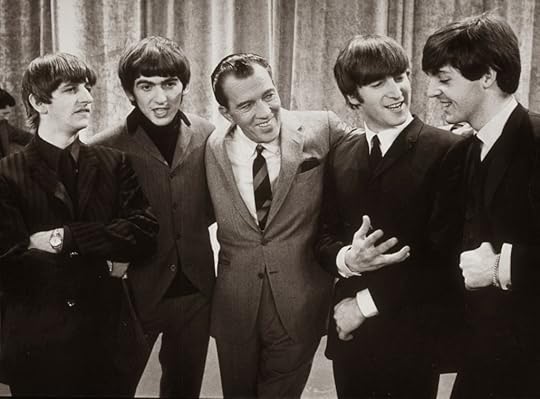
I was a junior in high school, sixteen. Not long after the Beatles first appeared on the "Ed Sullivan Show," I stood at the front entrance to Morton High with my friend, Donna, the two of us discussing the cuteness quotient of John, Paul, George and Ringo. There was giddiness and screeching involved—what had already been tagged “Beatle Mania.” I thought Paul was the cutest. I hadn’t yet figured out that you could also have a crush on a boy because of his mind.
It was the end of the school day; we were waiting for Donna's mom to pick us up. Classmates surged around us, carrying their books as kids did then: boys, at their sides; girls, hugged to their chests. It was cold. Everyone was bundled up in winter jackets, but girls couldn’t wear pants to school then, so their legs were bare. And God forbid, you should wear boots—no matter how severe the weather. Most girls wore white tennis shoes or flimsy Capezio flats, with nylons.
I wore white tennis shoes and white wool crew socks. I couldn’t thinkwearing nylons. (I still can’t.) Which maybe, just possibly had something to do with why boys did not find me all that alluring.
A while back, when I did a book signing in my hometown, a high school classmate appeared—a still- good-looking guy who had lived down the street from me. It was lovely to see him, so nice of him to come. I said, “I had a huge crush on you in high school.” He looked stricken, he stepped back. His hands went up, as if in defense.
“You were too smart,” he said.
He couldn’t get away from me fast enough.
The thing is, I was a good and earnest student in high school, smart enough, but nowhere near as smart as the smartest kids in our class. I was, however, intense. I mortified myself. I lived in a perpetual state of yearning. I yearned to be popular. I yearned for a boyfriend. I yearned to be known and accepted for who I was, though, looking back, it's clear I didn't even know who I was myself.
Mostly, I yearned to be writer--and I might have found a place for all that intensity and even some kindred spirits on the newspaper or yearbook staff, but I was too scared to take the required journalism class because I was afraid I wouldn’t be good enough. So that intensity was a loose cannon, exploding in weird, wrong times and places, never failing to make me feel worse about myself. Honestly, I wouldn’t have known what to do with a cool, handsome boyfriend should one have miraculously appeared to claim me.
Maybe, for some of us, the Beatles were vicarious boyfriends. Attainable boys were so…unsatisfying and, well, real. And it was perilous to have a crush on an unattainable boy. You didn’t dare talk about him, even to your girlfriends. You’d be teased mercilessly. Worse, what if the boy found out somehow? You would be ruined. You would want to curl up in a corner and die.
But you could go on and on and on about the Beatle of your choice like all infatuated people do about their beloveds, with no price—other than maybe boring everyone around you to tears. But people in love don’t realize they’re boring others. So who cared? And there was a Beatle for every girl. If you wanted a cute, charming boyfriend, Paul was the one for you. If you wanted a smart, witty boyfriend, John was the clear choice. Soulful: George. Just your basic guy, only…a Beatle: Ringo.
Knowing that the odds of even setting eyes on your beloved Beatle were about the same as said Beatle actually falling in love with you were pretty much zero, only made it all the more delicious. You could zone out, fantasizing. You could listen to “That Boy” over and over, knowing you could mend your Beatle’s heart if only he could find you—and wouldn’t you be a way better girlfriend, anyway? Or you could listen to “I Saw Her Standing There,” imagining you were the girl your particular Beatle was seeing that first time and knowing, in an instant, that he'd been looking for you all his life.
Ah, (safe) love.
Published on February 09, 2014 10:28
December 31, 2013
Funny How Writing Works

Funny how writing works. Not so funny how, when for reasons legitimate and absurd—despite the excellent advice you give to others—you don’t write for a while and it seems impossible to begin again. Which is pretty much where I find myself at the end of this rather difficult year. I could play the breast cancer card; being sick for a while certainly does rock your world. But, okay, that pretty much over by April—and, while I was tired and there was a lot of catching up to do, I felt fine by early summer. I feel fine, now.
So, Jeez. Write.
But what? There were so many things I meant to write about in 2013. Maybe I tried and couldn’t make them seem interesting, even to me. Maybe, more likely, they didn’t seem possible. Hello. Which is a big part of why you (we) need to write something every day. One idea leads to another idea. Words lead to more words.
Anyway. Last night I promised myself I would not end the year in a slump. I would get up in the morning and write something. But when I sat down at my desk, everything still seemed either bland or impossible. I thought, okay, how hard could it be to write about my favorite books of 2013? That perked me up a bit. It felt possible, though unlikely to involve much, if any, process. Still. It would be a start.
Probably to avoid that start, I Googled “Quotes about Books.” A gazillion popped up; you’d probably be familiar with most of them I read. You might know this quote from St. Augustine’s Confession, too. “The world is a book, and those who do not travel read only a page.” I remember reading it somewhere myself. But today, for some reason, it created a small combustion in my mind. Books and travel; travel and books.
When I was a girl, books were the only way out of a world where I so did not want to be. There were train tracks just beyond the backyard of a house we lived in for a while, and sometimes I’d stand and watch the passenger trains go by. Their lit windows at dusk, the people inside, reading, chatting, dozing filled me with longing. Where are they going, I’d wonder. Did the people looking out the window notice me? If they thought of me, that girl watching the train go by, when they reached their destinations, wouldn’t it be a little like being there myself?
Before I could read by myself, Eloise made me want to live in the Plaza Hotel in New York. In grade school, I gravitated toward books about perfect families, perfect friendships. The “Little House” series, which made the harsh life of pioneers seem glamorous; “Betsy, Tacy and Tib's,” deep bonds to one another made Minneapolis seem exotic to me. If I went there, would I have friendships like that, too?
I loved books like The Boxcar Children, in which spunky, resourceful children solved their own problems and made independent lives. I adored shabby gentility of Little Women, four sisters—so different, yet so fiercely loyal to one another. Little Women's Jo made me want to be a writer—though, I see now, was awfully pious and set a ridiculously high standard for selflessness. Nonetheless, I still have it on a shelf near my desk—a beautiful, illustrated book that my Uncle Joe gave me for Christmas when I was ten. The pages are worn from reading and rereading. It falls open to the scene where Beth dies and Jo grieves for her.
The books my English grandparents sent took me to London—a world my mom talked about with a yearning that made me sad. Big Ben. Red double-decker buses. Rows of neat brick houses, the windows and the brass fittings on their doors polished until they gleamed. A place where people wore “jumpers,” not “sweaters.” Where they went on “holiday” instead of “vacation.” Where “favor” was “favour” and “theater,” “theatre.” These things thrilled me. In time, I discovered Jane Eyre and Wuthering Heights. What were moors, I wondered. What, exactly, did a primrose look like?
The more I read, the more I wanted to travel into the real worlds of the books I loved. I vividly remember my first view of England—from the air. “We’ve gained land,” the pilot announced. “If you look down…”
A thrill shot through me; at the same time, I felt like I might cry. I thought, what if it’s nothing like I imagined? What if it’s just like everyplace else? It took me a moment to gather the courage to raise the shade. But, oh! When I did! There it was: a patchwork of green fields, villages here and there, even the occasional thatched cottage. It felt like going home—which, at the time, I assumed was because my mom and been born and lived there before she met my dad. But now, writing, it occurs to me that arriving in the places I’ve read about in books always makes me feel as if I've come home—that each book is a home in its own right, not just an escape from a home that makes you unhappy.
Note to self: Isn’t it so cool how, suddenly, you write something utterly new? How you feel a kind of map inside you, guiding you and how, even though you can’t see it, you trust it to take you where you need to go?
“Life can only be understood backward, but it must be lived forward,” Kierkegaard said. Writing is like that, too. You can’t understand what you’re writing until you’ve written it and look back to see what you said.
But what about St. Augustine: "The world is a book, and those who do not travel read only a page." It sparked something; it got me going. It made me think of traveling through books and traveling into books. But looking at the quote again, it's clearly about point of view. Books take you to other places, but they also take you into other people’s lives and minds. In the end, this is probably the most important thing that books do. It seems strange to me that the quote set me on a whole other path.
Maybe a topic for another day. Maybe I’ll start writing about that and end up in a whole other place. The idea excites me. Writing, going where writing takes me, excites me.
But I only remember this when I write.
So, duh. Again.
In any case, if you were counting on that list of books I loved in 2013 that I didn’t end up writing about either, here you go.
· Blood of the Lamb/Sam Cabot (Full disclosure: Sam Cabot is really my pals SJ Rozan and Carlos Dews. Nonetheless a fabulous book with a “Whoa!” ending.· Dear Life/Alice Munro· Billy Lynn’s Long Halftime Walk/Ben Fountain· Benediction/Kent Haruff· The Unlikely Pilgrimage of Harold Frye/Rachel Joyce· Life after Life/Kate Atkinson· The Burgess Boys/Elizabeth Strout
· All of the Harry Potter Books/JK Rowling (Thanks, Heidi!)· The Humanity Project/Jean Thompson· The Dinner/Herman Koch· Stoner/John Williams· The Black House & The Lewis Man/Peter May· Fools/Joan Silber· The Interestings/Meg Wolitzer
· Just One Evil Act/Elizabeth George· We Are All Completely Beside Ourselves/Karen Joy Fowler· Dr. Bird’s Advice for Sad Poets/Evan Rosko· Vienna/Eva Menasse· Fort Starlight/Claudia Zuluaga· The Goldfinch/Donna Tartt· The Yonahlossee Riding Camp for Girls/Anton Disclafani· Wonder/JR Placio· When We Were Bad/Charlotte Mendelson· Consequence/Penelope Lively
Happy reading in 2014!
Published on December 31, 2013 05:21
August 8, 2013
Watching Edith Paint
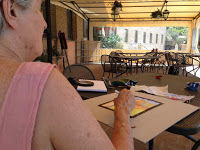 I am a painter for two weeks each summer, at Art Workshop International in Assisi. This year I came feeling uncertain about what I wanted to do, couldn’t quite connect with anything until I spent an hour or so watching Edith Isaac-Rose paint. I sat slightly behind her, so I couldn’t see her watercolors and didn’t have any idea what color she had on her brush until she put it on the paper in a big swath. I was shocked several times, in the happiest way. Yellow! Red!
I am a painter for two weeks each summer, at Art Workshop International in Assisi. This year I came feeling uncertain about what I wanted to do, couldn’t quite connect with anything until I spent an hour or so watching Edith Isaac-Rose paint. I sat slightly behind her, so I couldn’t see her watercolors and didn’t have any idea what color she had on her brush until she put it on the paper in a big swath. I was shocked several times, in the happiest way. Yellow! Red!We were on the terrace of the Hotel Giotto, the geometry of walls and roofs before us, broken by trees, flowers, chimneys and, in the distance, the mountains, fields, sky. I could see a vague outline of the scene on Edith’s watercolor paper in the beginning; but in time the particulars disappeared, colors and shapes told each other what to do and Edith, stopping, looking, let them do it.
She didn’t explain what she was doing, just did it. In fact, if she had given me a lecture on abstraction, I doubt I would have understood it nearly as well as I understood what abstraction was by watching the scene before us morph into shapes and planes and colors beneath her brush.
 Later, I stood before my easel in the studio, looking at the print of a photo I’d taken above the cloisters of the Basilica, thinking, when my friend Charles Kreloff came by and started talking about the planes in it. Suddenly, I saw it in the image in a completely different way.
Later, I stood before my easel in the studio, looking at the print of a photo I’d taken above the cloisters of the Basilica, thinking, when my friend Charles Kreloff came by and started talking about the planes in it. Suddenly, I saw it in the image in a completely different way. 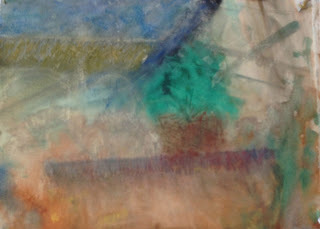 Over the next few days I did a flurry of abstract paintings of that corner of the cloisters.
Over the next few days I did a flurry of abstract paintings of that corner of the cloisters. 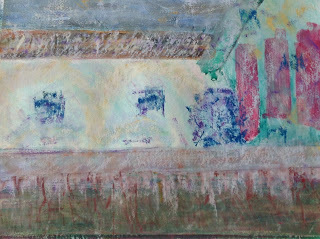
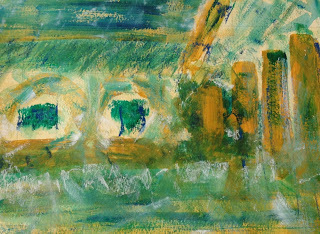
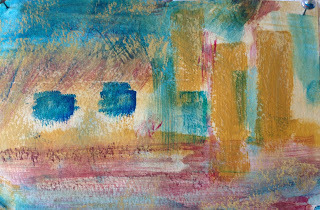
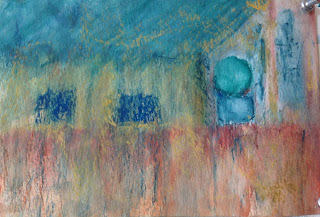
I loved playing with the same elements over and over, observing how each painting was the same and different from the others—and it occurred to me that a painter’s material is no different from a writer’s material. The “stuff” from which we make paintings, the bits and pieces of the real world to which we’re drawn because of who we are, what shaped us, is exactly like the stuff from which we make stories. Loaded into the kaleidoscope of the mind, it tumbles into a new painting with each turn—then lifts, morphs to create its own unique piece of the universe.
Published on August 08, 2013 04:44
July 24, 2013
Three Hovering Angels
Every summer I teach writing to children at the St. Florian Center Leadership Development Camp for Youth. It is an amazing program, founded and coordinated by amazing (mostly) African American firefighters who care deeply about kids--and do something about it. I've been teaching writing to people of all ages for nearly forty years and one of the things I love most about it is how, now and then, I get totally blown away by something written by an absolute novice. This happened Monday with the St. Florian kids.
The funny thing was, we were disorganized that morning, mixed up about what the kids had and hadn't already done. Turned out, at least some of them had done everything we had in mind to do with them. On the spur of the moment, I'd grabbed a bunch of art postcards and taken them with me--just in case. So we handed them out to the kids in a random manner and put them to work. Here's some writing that came from the exercise, my favorite being "Hovering Angels" by Janai. She wrote this on her own, with no help from anyone. It makes the hair on my neck stand up.
I wish I could be her hovering angel in real life, take care of her and keep her gorgeous voice strong and safe. I wish I could be a hovering angel for them all.
 “Three Hovering Angels” (artist unknown)
“Three Hovering Angels” (artist unknown)
By Janai
Angel, angel, that’s what I am. A sweet darling in air floating mode. I am sweet as a baby. Innocent. I’m also not innocent sometimes. I have a gold wing and a black wing. The gold is for strong and black is weak. I’m strong. I have a void in my life. My daddy took it. I don’t try to fill the void. I work around it. My life is a triangle. I’m in the center. The first tip is for my god, the second tip is for my daddy, the third is my mom. It hurts in the center because you have to keep from turning. But when I look in the mirror I feel strong again.
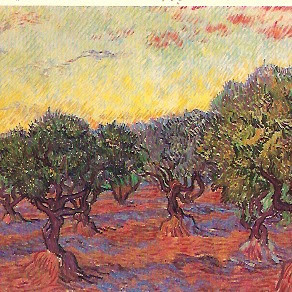 Vincent VanGogh’s “Olive Orchard”
Vincent VanGogh’s “Olive Orchard”
By Mar’Kayla
There once was swavey trees going with the wind, with blue and orange ground and yellow, some blue and some red skies. The trees look like big and leafy hula dancers. The grass looks like hay. Suddenly the bright and shiny sun started to rise. A small bird came past with a blast. All you could see were baby birds chirping. If I went to Olive Orchard then I would lay on the grass going up on the trees or build me a fort made out of the grass, sticks and tree branches. I may even build me lots of homes for either pets or for people to look around.
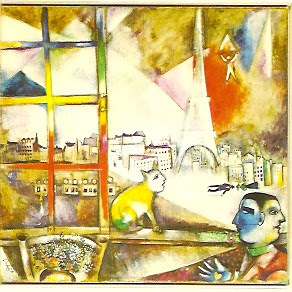 Marc Chagall’s “Paris through the Window”
Marc Chagall’s “Paris through the Window”
By Hope
Once upon a time there was a cat and he was yellow. He’s looking at the flying people. There is a boy and he is on a cat flying up in the air. He saw people on the ground. There’s two boys with two faces and they’re on the news. It told about what happened to the people on the ground by the Eiffel Tower. The can remembered something from when he was a baby. It was a train. He was dizzy. He’s like Humpty Dumpty on a wall. If I went in that place I would be flying on a kite and I would be a cat, too.
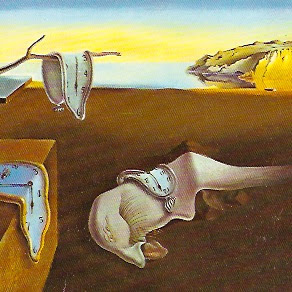 Savadore Dali’s “The Persistence of Memory”
Savadore Dali’s “The Persistence of Memory”
By Jordan J
I’m a man, a flat clock man, with flat clocks around me and with a flat ocean and flat mountains around me and, well, everything is flat in this city. There is a tree that’s not flat. Would you look at that! I’m a flat clock man dancing. I’m dancing like Michael Jackson with gold and silver and shiny white teeth. I’m dancing to their beat.
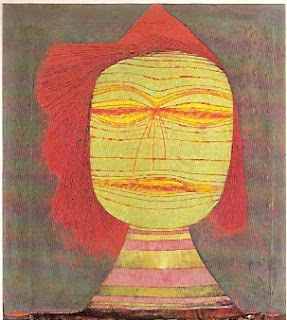 Paul Klee’s “Actor’s Mask”
Paul Klee’s “Actor’s Mask”
By Nia
Once upon a time there was a girl that had a volcano on her head. Her name was Voltina. She went to the park and when she was there she saw her friends and got mad at them. So her volcano erupted. There was lava everywhere, so the park was closed.
Salvador Dali
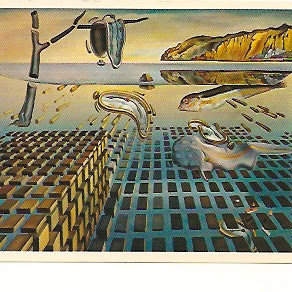 Salvador Dali’s “The Disintegration of the Persistence of Memory”
Salvador Dali’s “The Disintegration of the Persistence of Memory”
By Elijah
Orange earrings shooting across the air, if anyone saw it they have to prepare. Tree cut into halfs, time clocks to make children laugh and laugh. Time is going faster by heat, faster than anyone can ever beat. Dead fish in the water, people see it and never bother. Little blocks to step and not fall, mountains big and tall. Trees drowning in water, there they go, farther and farther.
The funny thing was, we were disorganized that morning, mixed up about what the kids had and hadn't already done. Turned out, at least some of them had done everything we had in mind to do with them. On the spur of the moment, I'd grabbed a bunch of art postcards and taken them with me--just in case. So we handed them out to the kids in a random manner and put them to work. Here's some writing that came from the exercise, my favorite being "Hovering Angels" by Janai. She wrote this on her own, with no help from anyone. It makes the hair on my neck stand up.
I wish I could be her hovering angel in real life, take care of her and keep her gorgeous voice strong and safe. I wish I could be a hovering angel for them all.
 “Three Hovering Angels” (artist unknown)
“Three Hovering Angels” (artist unknown)By Janai
Angel, angel, that’s what I am. A sweet darling in air floating mode. I am sweet as a baby. Innocent. I’m also not innocent sometimes. I have a gold wing and a black wing. The gold is for strong and black is weak. I’m strong. I have a void in my life. My daddy took it. I don’t try to fill the void. I work around it. My life is a triangle. I’m in the center. The first tip is for my god, the second tip is for my daddy, the third is my mom. It hurts in the center because you have to keep from turning. But when I look in the mirror I feel strong again.
 Vincent VanGogh’s “Olive Orchard”
Vincent VanGogh’s “Olive Orchard” By Mar’Kayla
There once was swavey trees going with the wind, with blue and orange ground and yellow, some blue and some red skies. The trees look like big and leafy hula dancers. The grass looks like hay. Suddenly the bright and shiny sun started to rise. A small bird came past with a blast. All you could see were baby birds chirping. If I went to Olive Orchard then I would lay on the grass going up on the trees or build me a fort made out of the grass, sticks and tree branches. I may even build me lots of homes for either pets or for people to look around.
 Marc Chagall’s “Paris through the Window”
Marc Chagall’s “Paris through the Window”By Hope
Once upon a time there was a cat and he was yellow. He’s looking at the flying people. There is a boy and he is on a cat flying up in the air. He saw people on the ground. There’s two boys with two faces and they’re on the news. It told about what happened to the people on the ground by the Eiffel Tower. The can remembered something from when he was a baby. It was a train. He was dizzy. He’s like Humpty Dumpty on a wall. If I went in that place I would be flying on a kite and I would be a cat, too.
 Savadore Dali’s “The Persistence of Memory”
Savadore Dali’s “The Persistence of Memory”By Jordan J
I’m a man, a flat clock man, with flat clocks around me and with a flat ocean and flat mountains around me and, well, everything is flat in this city. There is a tree that’s not flat. Would you look at that! I’m a flat clock man dancing. I’m dancing like Michael Jackson with gold and silver and shiny white teeth. I’m dancing to their beat.
 Paul Klee’s “Actor’s Mask”
Paul Klee’s “Actor’s Mask”By Nia
Once upon a time there was a girl that had a volcano on her head. Her name was Voltina. She went to the park and when she was there she saw her friends and got mad at them. So her volcano erupted. There was lava everywhere, so the park was closed.
Salvador Dali
 Salvador Dali’s “The Disintegration of the Persistence of Memory”
Salvador Dali’s “The Disintegration of the Persistence of Memory”By Elijah
Orange earrings shooting across the air, if anyone saw it they have to prepare. Tree cut into halfs, time clocks to make children laugh and laugh. Time is going faster by heat, faster than anyone can ever beat. Dead fish in the water, people see it and never bother. Little blocks to step and not fall, mountains big and tall. Trees drowning in water, there they go, farther and farther.
Published on July 24, 2013 05:29
July 11, 2013
Lucky Me
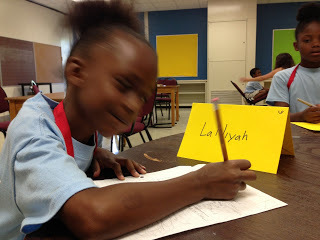 Every now and then, there’s a perfect day.
Every now and then, there’s a perfect day. Yesterday morning, I worked with the little ones at our summer writing program at St. Florian Center's Youth Leadership Development Camp, drawing stories out of them, helping them put the words down on the page. One of the little girls, LaNiyah (7), stroked my inner arm while I was writing.
“Your arm is soggy,” she said.
I laughed. “That’s because I’m old,” I said.
She looked at me, considered, then said cheerfully, “You still have teeth, though.”
“I do!” I said. “And that is a good thing.”
I especially love the little ones. They’re so lovely to look at, so full of life. I love watching our college interns and volunteers work with the kids of all ages. They come up with great stuff to keep them on track.
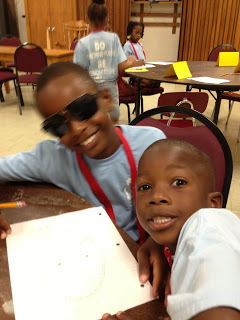 Michael had a pair of sunglasses, which the kids naturally wanted to try on. “Okay,” he said. “The first person to write a sentence gets to wear them till the next person finishes one.” He kept them writing that way, sentence by sentence, passing the glasses around the table.
Michael had a pair of sunglasses, which the kids naturally wanted to try on. “Okay,” he said. “The first person to write a sentence gets to wear them till the next person finishes one.” He kept them writing that way, sentence by sentence, passing the glasses around the table. 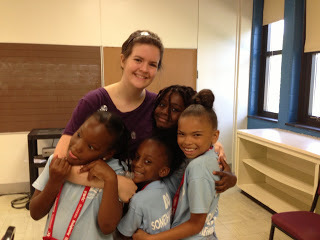 Leeann was working with some of kids that were having trouble concentrating. “You need to get to work,” she said—then thought, but what are the consequences if they don’t. She added, “…because I’m going to be so disappointed if I don’t get to read the stories you have inside your heads.” This surprised them. They wrote. When I was taking pictures yesterday, they all wanted to have their pictures taken with her.
Leeann was working with some of kids that were having trouble concentrating. “You need to get to work,” she said—then thought, but what are the consequences if they don’t. She added, “…because I’m going to be so disappointed if I don’t get to read the stories you have inside your heads.” This surprised them. They wrote. When I was taking pictures yesterday, they all wanted to have their pictures taken with her. I went from St. Florian to my favorite bookstore, IndyReads, where our Latino middle-schoolers from LaPlaza gathered to browse the bookshelves and listen to what three young, very cool real writers had to say about writing. Bryan Furuness, Andrew Scott and Ben Winters volunteered their time to talk about writing when they were kids and writing now.
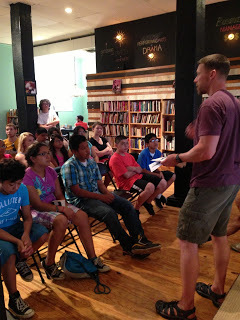 “It’s hard,” they all said. “Making an idea into a story is like taking care of a baby bird,” Ben said. “You have to feed it, nurture it until its wings get strong—and then, one day, it flies.”
“It’s hard,” they all said. “Making an idea into a story is like taking care of a baby bird,” Ben said. “You have to feed it, nurture it until its wings get strong—and then, one day, it flies.” “Read, read, read,” all of the writers told the kids. “Read what you want. Anything. ‘Good books’ are the ones you like, not the ones people say you should like. If you can’t afford to buy books, go to the library. It’s yours. You can check out any book you want.”
After the kids received autographed copies of the books Ben’s publisher had provided, I moved on to “my” library—the College branch of IMCPL at 42nd Street and College Avenue.
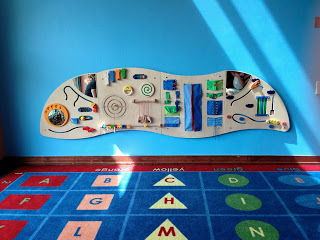 Last fall, I had the great pleasure of donating $2,500 to the branch as a result of winning the 2012 Eugene and Marilyn Glick Regional Indiana Authors Award. Yesterday, I got to cut the blue ribbon, officially opening the cozy corner they created for the littlest kids with the money. It has a cool activity wall, a bright alphabet rug, a nifty kid-size armchair next to the story phone, so they can sit and listen to a story—and a brass plaque nearby with my name on it.
Last fall, I had the great pleasure of donating $2,500 to the branch as a result of winning the 2012 Eugene and Marilyn Glick Regional Indiana Authors Award. Yesterday, I got to cut the blue ribbon, officially opening the cozy corner they created for the littlest kids with the money. It has a cool activity wall, a bright alphabet rug, a nifty kid-size armchair next to the story phone, so they can sit and listen to a story—and a brass plaque nearby with my name on it. 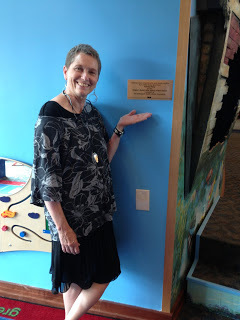 I sat down and tested out the wall with a couple of little boys who kept on playing, loving being at the library when I left to join IMCPL CEO Jackie Nytes was there; Danny Dean and Laura Wills from the Library Foundation” and, of course, the fabulous College branch librarians for a celebration with a groovy “Indiana Writers Rock” cake and raspberry lemonade.
I sat down and tested out the wall with a couple of little boys who kept on playing, loving being at the library when I left to join IMCPL CEO Jackie Nytes was there; Danny Dean and Laura Wills from the Library Foundation” and, of course, the fabulous College branch librarians for a celebration with a groovy “Indiana Writers Rock” cake and raspberry lemonade. Finishing off this very excellent, day my husband and I bicycled up the Monon Trail to Bazbeaux Pizza in Carmel, where we had a huge salad and our favorite pepperoni, onion and red pepper pizza…then cycled the calories off (well, some of them) on the way home.
Luck,lucky me.
Published on July 11, 2013 11:48



